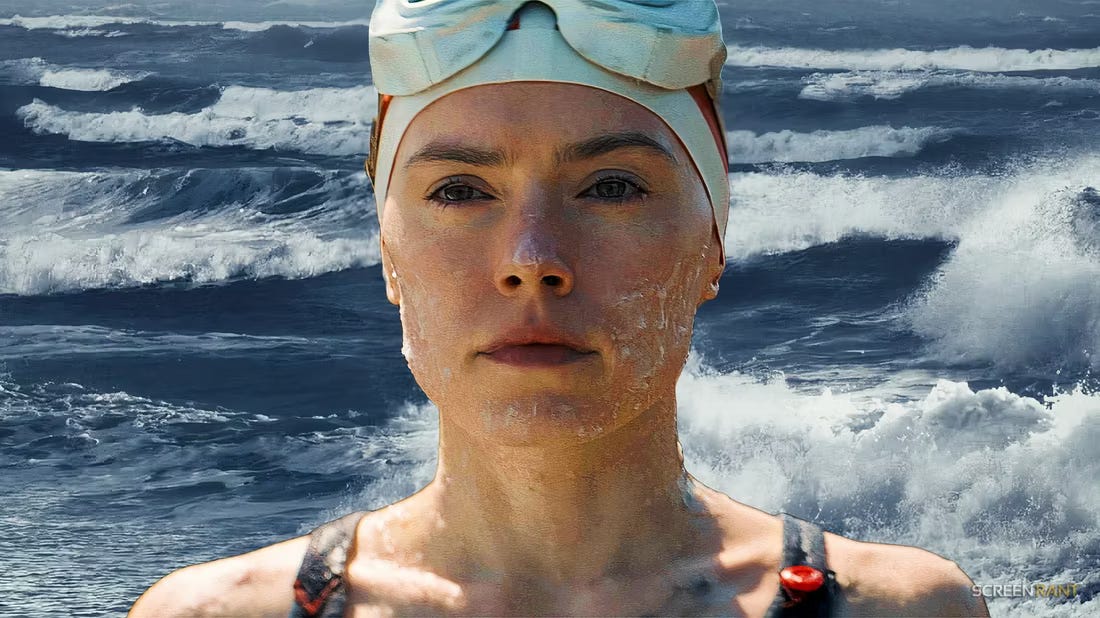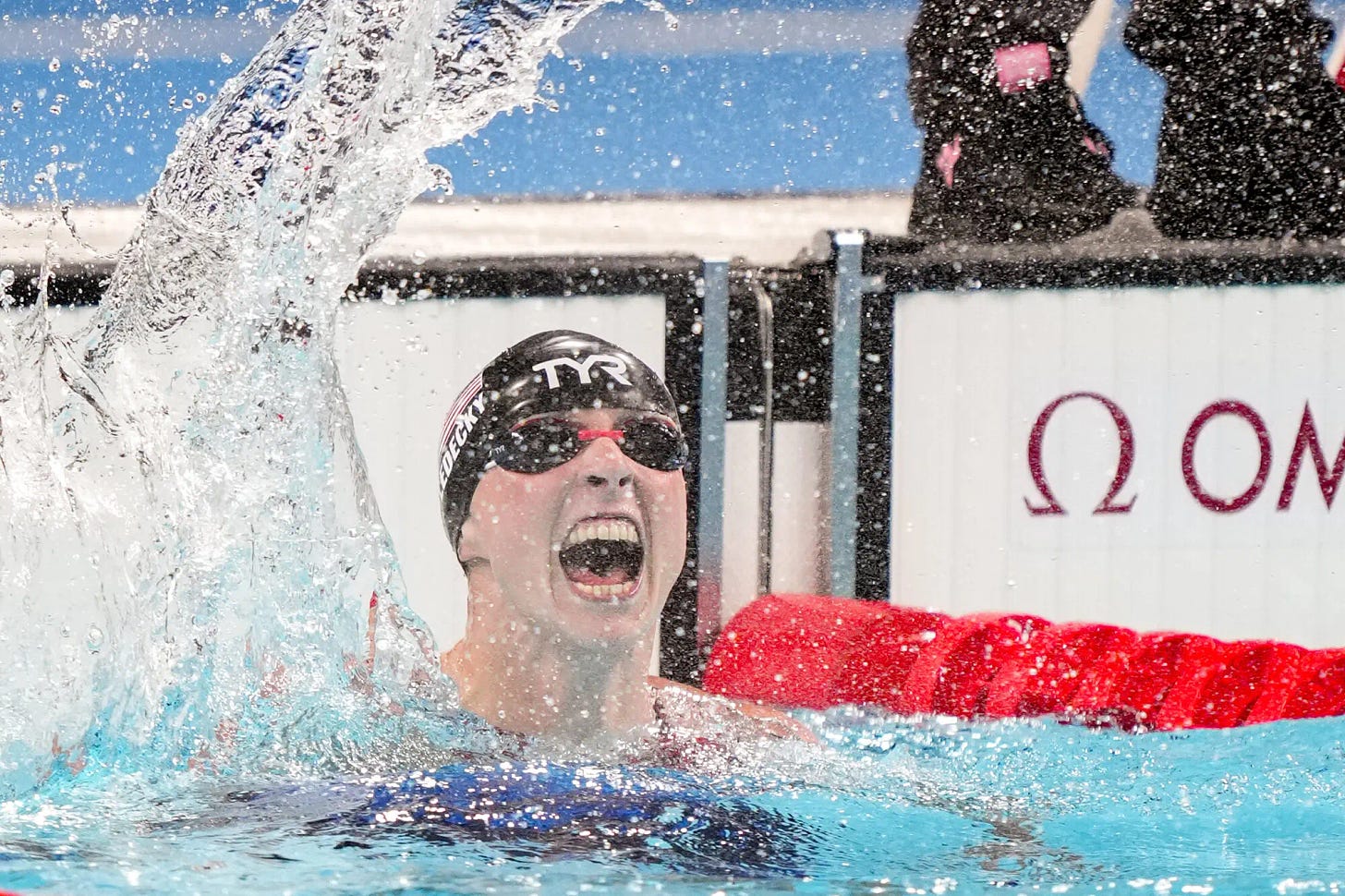From the River to the Sea to the Pool
Cultivating pride, determination, and resilience in the water
Monday morning, 9 AM. The pool is deserted. The lifeguard says I can pick any lane. The water is balmy, cloudy with chlorine.
I haven’t swam in nine days, not since I swam a mile across the Hudson River with two friends and 200 strangers. And I haven’t swam in a pool in 10 days, not since the last day of Adult Swim camp.
To fill the void, I binge-watched Olympic swimming, trained my new dog named River, and streamed two swim films: the Disney drama Young Woman and The Sea and the Netflix comedy special The Old Man and the Pool. Meanwhile, I quietly celebrated seven months of swimming-fueled sobriety.
Today, after the swim hiatus, my shoulders no longer ache. The spontaneous back spasms have stopped. And the archipelago of acne that erupted below my armpit, near my nipple, and between my shoulder blades—has abated. At first, I thought funky river water had inflamed my skin. Then I realized the culprit was the Vaseline I swabbed in gobs on my torso, arms, and legs before I jumped in the water.
Now the stagnant gym pool feels tame after swimming across a choppy river. Compared to the sprawling 50-yard laps at Adult Swim, the 25-yard lengths here feel truncated. And after six weeks of sunrise swims outdoors, the indoor pool—with its fluorescent lights and white ceiling beams—feels like an airplane hanger or Wal-Mart.
For the first time in three months, I’m not practicing for a specific swim goal. For the first time in two years, I’m not following a multi-week swim training regimen. Instead, I’m Going Rogue (My Version). Today that means a random online swim workout. I focus my efforts on kicking, perhaps my weakest skill. I move faster, but tire more easily. The surprising highlight of the session is backstroke. During Adult Swim, backstroke was wobbly and erratic and I often got water up my nose, but today I’m sluicing through the pool like a streamlined missile. Your move, Kaylee McKeown!
Going for Gold
Olympic swimming is a master class in pageantry and performance, sport and spectacle.
Before each race, the swimmers emerge one by one from backstage, clad in warm-up clothes—puffy coats and track suits—in their national colors. The Netherlands in Orange. China in Red and Yellow. Australia in Yellow and Green. When a French swimmer emerges, the hometown crowd cheers “Allez,” especially if that swimmer is León Marchand, who won four gold medals and a multimedia montage projected inside La Defense arena.
The swimmers disrobe and take their assigned lanes: the fastest in the center lanes, the slowest in the outer lanes. Eight taut bodies crouch and coil on the starting blocks, then uncoil and explode into a dive.
For the first few meters, they undulate dolphin kicks. If they’re swimming butterfly, they’ll maintain the dolphin. If not, they’ll switch to a flutter kick for freestyle or backstroke or a frog kick for breaststroke. In most races, they breathe every two strokes. But some sprinters can swim 50 meters without taking a single breath.
Whatever their stroke, whatever the distance, their speed is incomprehensible.
Australian Camron McEvoy wins the 50m freestyle gold in 21:25 seconds. Katie Ledecky wins the 1500m freestyle gold in 15:30. In the same event, Bobby Finke breaks the world record and wins gold in 14:30.
I am not and have never been a competitive swimmer, much less a world-class athlete.
Still, the math is hard to ignore: Olympians swim three times faster than I do. At least.
How many thousands of hours have they practiced? What sacrifices have they made? What keeps them motivated?
I also learn that several Olympic swimmers are the sons or daughters of former Olympic swimmers. Talk about parent pressure.
“And you think I’m tough,” I say to my son.
“No I don’t,” he says.
Young Woman and the Sea
August 1926. Trudy stands on the shore in a bathing suit, swim cap, and goggles. She smears her skin with gloppy gunk, sheep fat to warm her body in the frigid water. She sings, in a wobbly voice: “Every morning, every evening/Ain’t we got fun?” Last summer, she tried to swim across the English Channel—and failed. Now, she does not want to fail again.
Or at least that’s the opening scene of Young Woman and The Sea, a new Disney biopic about Gertrude Ederle, the first woman to swim across the English Channel, starring Daisy Ridley as Ederle.
Beyond her staggering physical feat—swimming 21 miles in 14 ½ hours—Ederle was also a feminist trailblazer. As Young Woman dramatizes, she battled and dismantled sexist stereotypes and patriarchal norms about what women could—or should—do.
Nearly 100 years later, female swimmers are ubiquitous at all levels. But the culture wars in athletics have shifted to transgender athletes, such as swimmer Lila Thomas. (For a nuanced take on the issues at play, see Katie Barnes, Fair Play: How Sports Shape the Gender Debates)
Meanwhile the question of what woman can or should do continues to haunt sports and, for that matter, politics.
More than a century after Congress granted women the right to vote, women comprise less than 30% of Congress.
And the United States (still) has not elected a female President.
Pride: “This is our house, coach!”
With its inspiring intersection of swimming and social justice, Young Woman and the Sea reminds me of Pride, a 2007 biopic about Black swim coach Jim Ellis, who leads an upstart swim team of Black teenagers to victory in the 1974 regional swim championship. The team calls itself PDR, short for Philadelphia Department of Recreation. PDR is also the acronym for their motto: Pride. Determination. Resilience.
In the first scene, a young Black swimmer arrives at a meet in North Carolina 1964. The all-white crowd boos him and refuses to let him compete. The swimmer—and his coach—insist on his right to swim. A white police officer orders him to get his “black ass” out of the building. A struggle ensues. The swimmer punches the cop. The scene ends with a close-up of the cop’s shoe pinning the swimmer’s skull to the ground.
A decade later, history repeats itself—with a twist.
The swimmer is now a swim coach, played by Terrance Howard. After months of training, his newly formed team hosts a meet at the local recreation center, painstakingly restored and rescued from condemnation. When their rivals—the all-white Main Line Barracudas—arrive, their coach announces a surprise: His swimmers have contracted a sudden illness and can’t compete. Infuriated by the flagrant act of humiliation, the Black coach demands the reversal count as a forfeit. The white swim official, buddies with the white coach, refuses. The white team exits, laughing. Coach, swimmers, and crowd are all devastated.
Then one boy ascends a starting block and declares: “This is our house, coach.” The coach fires the starting pistol. The boy dives into the pool and swims. One by one, each swimmer climbs a block, repeats the affirmation, and dives into the water.
I rarely cry at movies, but while watching this scene, my eyes pool with tears, moments before the coach begins to weep.
The Old Man and the Pool
In his latest stand-up comedy show, The Old Man and the Pool, Mike Birbiglia recounts how he started swimming in his forties to avoid the fate of his father and grandfather.
“My dad had a heart attack when he was 56, and actually, his dad had a heart attack when he was 56,” he tells his doctor. “So I’ve always thought I should set aside that whole year, get an Airbnb by the hospital, keep a flexible schedule. I think that might be a big year for me.”
When his doctor prescribes swimming, Burbiglia balks, traumatized by childhood trips to the YMCA, with its chlorine- and urine-saturated waters, and flagrant displays of locker room nudity.
At first, I was irritated by Birbiglia’s middle-aged schlub vibe and self-deprecating humor.
As the show progressed, his relentless vulnerability, deadpan delivery, and comic timing worked its magic.
I wonder if my initial aversion to Birbiglia was his familiarity. We’re both writers, husbands and fathers, who embraced swimming in midlife as a way to mitigate mortality. We both have Italian-American ancestry. And neither of us ever met our paternal grandfathers, who died from heart attacks before we were born.
Also, we were neighbors.
Birbiglia learned to swim—and took his daughter to swim lessons—at the Brooklyn YMCA, where I once swam and took my son to swim lessons. Even if never swam at the same time, we definitely shared a pool.
The point is: Spectacular swimmers like Gertrude Ederle, Katie Ledecky, and León Marchand may be role models of pride, determination, and resilience. And their accomplishments in the water are literally awesome, i.e. inspiring awe.
But ultimately they’re outliers—the elite of the elite.
By comparison, Birbiglia is a regular guy who makes a radical move to change his life. Essentially, The Old Man and the Pool suggests: if he can change, anyone can change.
Maybe we should meet up this summer for a swim?




